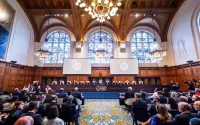12 April 2007Alister Doyle
Surging use of cars and planes will push up greenhouse gas emissions in coming decades, making the transport sector a black spot in a fight against global warming, according to a draft U.N. report.
"Transport activity is expected to grow robustly over the next several decades," according to a 101-page technical summary of a draft report by the U.N. climate panel, the most authoritative on threats from global warming.
The summary, to be issued on May 4 in Bangkok at a meeting of scientists and more than 100 governments, says efforts to curb emissions from transport "are faced with many barriers" despite options such as new engine technologies or biofuels.
Transport, mostly trucks and cars, accounted for 26 percent of total world energy use in 2004 and, barring a major shift, "projections foresee a continued growth in world transportation energy use by 2 percent a year, with energy use and carbon emissions about 80 percent above 2002 levels by 2030."
In some nations such as the United States, Italy and Australia car ownership is already 5 to 8 per 10 inhabitants -- 10 or 100 times more than in developing states.
The study projects biofuels could rise to 3 percent of total transport fuel by 2030, or to 10 percent if a penalty for emitting heat-trapping carbon dioxide were $25 a ton.
Measures such as tighter vehicle efficiency standards, lighter materials and better aerodynamics could double the fuel economy of new vehicles by 2030, roughly halving their emissions.
It foresees more use of hybrid cars but says, for instance, the outlook for hydrogen powered vehicles is uncertain.
The section on transport is part of a draft by the Intergovernmental Panel on Climate Change (IPCC) that says fighting global warming can be inexpensive but that governments are running short of time to avert big temperature rises threatening more droughts, heatwaves, floods and rising seas.
About 2 percent of total carbon dioxide emissions from human activities come from aviation. Emissions from this sector are likely to rise by 3-4 percent a year given projected annual traffic growth of 5 percent outpacing annual improvements in aircraft fuel efficiency of 1-2 percent, it says.
Planes also damage the climate in other ways, partly by emitting heat-trapping nitrous oxides at high altitude. "These effects are estimated to be about 2 to 4 times greater than those of aviation's CO2 alone," it says.
Extra charges for fuel or the inclusion of the aviation sector into a greenhouse gas trading system "would have the potential to reduce emissions considerably," it says.
http://www.reuters.com/article/topNews/idUSL1232162620070412?pageNumber=2






